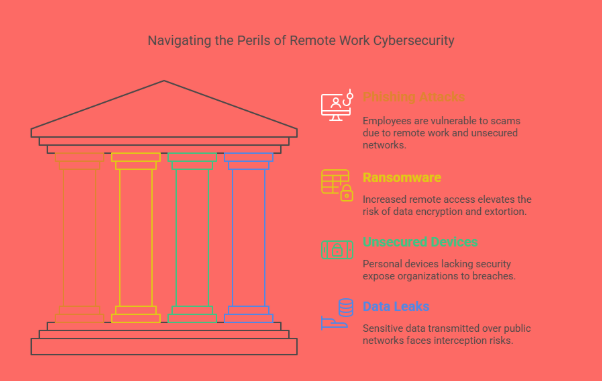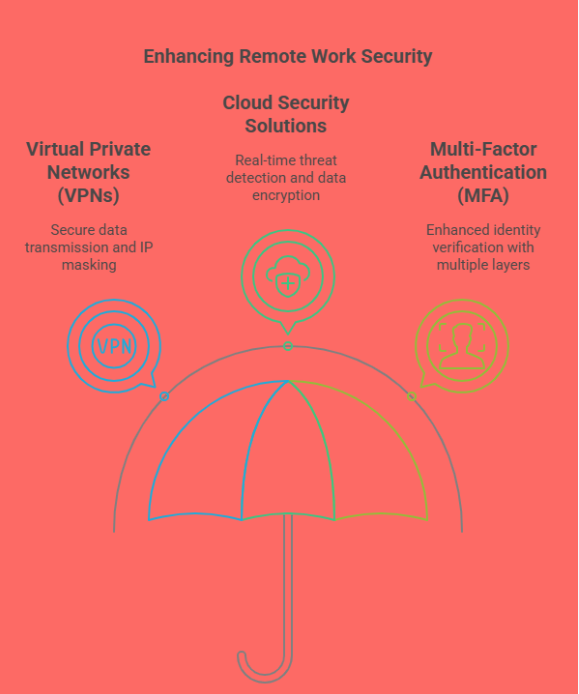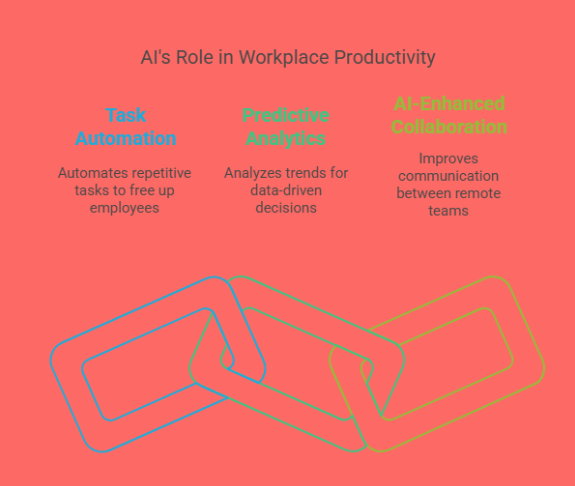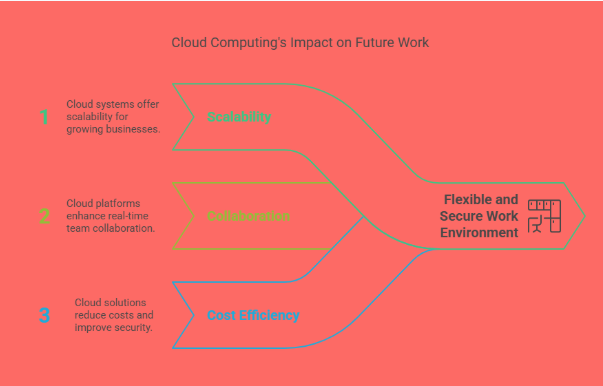The workplace of 2025 will look much different from what it does today, with the rapid growth of remote work, digital collaboration tools, and the increasing reliance on cloud technologies. As businesses evolve to adapt to these changes, Cyber Tech will play a pivotal role in ensuring that the digital transformation of the workplace is secure, efficient, and scalable.
From advanced cybersecurity measures to AI-driven tools that enhance productivity, Cyber Tech will be essential for managing the challenges and opportunities that arise in the future of work. In this blog, we will explore how Cyber Tech will impact the way we work, collaborate, and stay secure in 2025.
1. Remote Work and Cybersecurity
One of the most transformative changes to the modern workplace over the last few years has been the rapid rise of remote work. While remote work was gaining traction before, the COVID-19 pandemic significantly accelerated this shift. Companies across the globe were forced to adapt quickly, implementing work-from-home policies to maintain business operations during lockdowns and health crises. Fast forward to 2025, and remote and hybrid work models are not just temporary solutions—they are the new standard in many industries.
This evolution in how we work has brought numerous benefits. Employees now enjoy greater flexibility, improved work-life balance, and reduced commuting times. Businesses, on the other hand, can tap into a wider talent pool, hire globally, and reduce office-related expenses. However, while the advantages are many, the transition to remote work has also introduced a fresh set of cybersecurity challenges that organizations must address to remain secure and compliant.
Emerging Cybersecurity Threats in a Remote World
With employees accessing corporate resources from various locations, devices, and networks, the traditional concept of a centralized office network has dissolved. This decentralization creates more points of vulnerability, making it easier for cybercriminals to exploit weaknesses. Some of the most common threats in a remote work setup include:

-
Phishing attacks: Employees working outside the secure office network are more likely to fall victim to phishing scams, especially when using personal devices or unsecured Wi-Fi.
-
Ransomware: With more devices and data being accessed remotely, the risk of ransomware attacks has increased. Hackers can encrypt company data and demand payment for its release.
-
Unsecured devices: Employees may use personal or unmonitored devices that lack proper security configurations, exposing the organization to potential breaches.
-
Data leaks: When sensitive data is transmitted across public or unprotected networks, there’s a risk of interception and leakage, which can lead to financial and reputational damage.
To combat these threats, Cyber Tech solutions have become essential for companies embracing remote and hybrid work models.
How Cyber Tech Supports Remote Work
Implementing the right cybersecurity infrastructure is key to enabling remote work without compromising security. Here are some of the most critical Cyber Tech tools and strategies that businesses are leveraging to build a safe remote work environment:

1. Virtual Private Networks (VPNs)
A VPN acts as a secure tunnel between an employee’s device and the company’s network. By encrypting the data being transmitted, VPNs ensure that sensitive information remains protected from hackers or third-party interception. This is especially important for employees who may be working from coffee shops, airports, or other public Wi-Fi environments.
VPNs also help in masking IP addresses and maintaining anonymity online, further strengthening cybersecurity. Most companies have made VPN usage mandatory for all remote staff, adding a fundamental layer of protection.
2. Cloud Security Solutions
As businesses increasingly migrate to the cloud for data storage and collaboration, cloud security has become a top priority. Cloud environments, while efficient, are also susceptible to threats if not properly secured.
Cloud security solutions offer:
-
Real-time threat detection to identify and respond to suspicious activity
-
Encryption tools that protect data during storage and transmission
-
Access control and identity management systems that limit access to authorized users only
Cloud-native security tools also provide greater visibility and control over how data is accessed and shared, allowing IT teams to monitor usage and prevent unauthorized access.
3. Multi-Factor Authentication (MFA)
MFA has quickly become a non-negotiable element of any cybersecurity strategy, particularly for remote work. MFA requires users to verify their identity through at least two forms of authentication, such as:
-
A password or PIN
-
A biometric factor like a fingerprint or facial recognition
-
A one-time code sent to a verified device or email
By implementing MFA, businesses add an extra line of defense against unauthorized access—even if login credentials are stolen, a hacker would still need a second form of verification to gain entry.
Best Practices for Securing a Remote Workforce
Beyond deploying cybersecurity tools, businesses must also adopt best practices that reinforce a culture of security among remote employees:
-
Regular training: Educate employees on recognizing phishing attempts, using strong passwords, and reporting suspicious activity.
-
Endpoint protection: Ensure all employee devices—whether company-issued or personal—are equipped with updated antivirus software and firewalls.
-
Data backup and recovery: Implement automated backup systems to protect important data and reduce downtime in case of a cyberattack.
-
Security policies: Develop clear cybersecurity policies tailored to remote work, including guidelines for using public networks, data sharing, and device management.
The Future of Work and Cybersecurity
As remote work continues to evolve, cybersecurity must evolve with it. The lines between personal and professional devices are blurring, and work is increasingly being conducted in less controlled environments. In this new landscape, businesses that proactively invest in Cyber Tech solutions will be better positioned to protect their data, maintain productivity, and support employee well-being.
With the right tools—like VPNs, cloud security solutions, and MFA—and a commitment to cybersecurity awareness, companies can create a secure and seamless remote work environment. This approach ensures that employees can work from anywhere in the world without compromising on safety, confidentiality, or efficiency.
To learn more about cloud security solutions, check out our blog on How Cyber Tech Protects Your Cloud-Based Data.
2. AI and Automation: Boosting Productivity in the Workplace
Artificial Intelligence (AI) is rapidly transforming the way businesses operate, and by 2025, it will be an integral part of the workplace. AI-powered tools will not only enhance productivity but also play a significant role in improving workplace security.

How AI Impacts Productivity:
-
Task Automation: AI can automate repetitive tasks such as data entry, scheduling, and customer service inquiries, freeing up employees to focus on more strategic and creative tasks.
-
Predictive Analytics: AI-driven analytics tools can help businesses make data-driven decisions by analyzing trends, forecasting future demands, and identifying potential opportunities or risks.
-
AI-Enhanced Collaboration: AI tools can improve communication and collaboration between remote teams. For example, AI-powered virtual assistants can schedule meetings, manage emails, and provide real-time language translation, making it easier for employees to collaborate across time zones and languages.
As AI continues to evolve, its integration into daily work processes will streamline operations, allowing businesses to operate more efficiently while ensuring a secure environment.
3. Cybersecurity’s Role in Digital Transformation
In 2025, businesses will be deeply integrated into digital ecosystems, with almost every aspect of business relying on digital tools, cloud platforms, and online collaboration. While this digital transformation offers incredible opportunities for growth and innovation, it also creates an expanded attack surface for cybercriminals.
Cyber Tech's Role in Securing Digital Workspaces:
-
Endpoint Protection: With more employees working on multiple devices, endpoint security will become increasingly important. Cyber Tech solutions such as endpoint detection and response (EDR) will protect devices from cyber threats, ensuring that sensitive data on laptops, smartphones, and other devices remains secure.
-
Identity and Access Management (IAM): IAM solutions help businesses control who has access to specific data and applications. By implementing robust IAM solutions, companies can ensure that only authorized users can access sensitive information, which is crucial in the digital age.
-
Zero-Trust Security: The Zero-Trust model, which assumes that no one, inside or outside the organization, can be trusted by default, will become more prevalent in 2025. This model helps businesses protect their data by continuously verifying users, devices, and applications before granting access to resources.
As more businesses shift toward digital-first operations, Cyber Tech will be essential for ensuring that these digital ecosystems remain secure and resilient against emerging cyber threats.
4. The Role of Cloud Computing and Virtual Workspaces
Cloud computing has already revolutionized the way businesses store and manage data, and by 2025, its influence on the workplace will be even greater. As more companies move their operations to the cloud, Cyber Tech will play a vital role in securing cloud-based systems and ensuring smooth, efficient collaboration across remote teams.

How Cloud Computing Impacts the Future of Work:
-
Scalability: Cloud-based systems offer scalability, allowing businesses to grow without needing to invest in additional on-premise infrastructure. This scalability is essential for companies with expanding teams or growing data needs.
-
Collaboration: Cloud platforms like Google Workspace, Microsoft 365, and others will continue to evolve, offering secure, collaborative environments where teams can work together in real time, regardless of their physical location.
-
Cost Efficiency: Cloud solutions reduce the costs associated with maintaining physical servers and data storage. By moving to the cloud, businesses can reduce overhead costs while benefiting from advanced security features and automatic updates.
By integrating cloud computing and cloud-based collaboration tools, businesses can enable a more flexible, scalable, and secure work environment for employees.
For more on cloud security, read our article on What Are the Latest Cyber Tech Trends in 2025?.
5. The Growing Need for Digital Skills and Cybersecurity Training
As Cyber Tech continues to play a pivotal role in the workplace, employees must be equipped with the skills needed to navigate digital systems and stay secure online. By 2025, organizations will place even greater emphasis on continuous cybersecurity training and digital literacy to ensure their workforce is prepared for the future.
How Digital Skills Will Impact the Future of Work:
-
Cybersecurity Awareness: Employees will need to understand the basics of cybersecurity, such as recognizing phishing attempts, using strong passwords, and adhering to security best practices.
-
Training Programs: Organizations will invest in training programs to ensure that their workforce is up-to-date on the latest Cyber Tech tools and technologies. Cybersecurity training will be especially critical as employees use more digital tools and interact with cloud-based systems.
-
Cross-Functional Collaboration: As digital tools and AI-driven systems become more common, employees across all departments will need to collaborate using technology, from sales and marketing to finance and IT. Strong digital skills will be key to enabling effective communication and collaboration.
In 2025, the future of work will require a tech-savvy workforce capable of navigating a world dominated by Cyber Tech.
Conclusion:
The workplace of 2025 will be more digital, more interconnected, and more dependent on Cyber Tech than ever before. From securing remote work environments and enhancing productivity with AI to embracing cloud-based workspaces, Cyber Tech will be integral to shaping the future of work. As we move forward, businesses that invest in the right cybersecurity tools, continuously train their employees, and stay ahead of emerging tech trends will thrive in an increasingly digital world.
At ACSMI, we understand the importance of cybersecurity in the workplace. We are committed to providing businesses with the resources, knowledge, and certifications needed to succeed in the digital age and ensure the future of work is secure, efficient, and scalable.
FAQs
1. How will Cyber Tech influence remote work in 2025?
In 2025, Cyber Tech will play a crucial role in enabling secure remote work environments. With advanced tools like Virtual Private Networks (VPNs), cloud security solutions, and multi-factor authentication (MFA), businesses can ensure that remote employees stay connected securely. These technologies will protect sensitive data, ensure seamless collaboration, and safeguard against cyber threats, allowing businesses to maintain productivity while working from anywhere.
2. What role will Artificial Intelligence (AI) play in the future of work?
Artificial Intelligence (AI) will significantly enhance productivity in the workplace by automating repetitive tasks, analyzing data, and providing predictive insights. By 2025, AI-driven tools will help businesses streamline operations, improve decision-making, and boost efficiency. AI will also enhance security by detecting anomalies and responding to cyber threats in real-time, ensuring that businesses can stay ahead of evolving cyber risks.
3. How will cloud computing impact the workplace by 2025?
By 2025, cloud computing will continue to be a fundamental part of the workplace. Cloud-based solutions will enable businesses to scale their operations efficiently, store data securely, and collaborate seamlessly across remote teams. Cloud security solutions will ensure that data is protected and accessible from anywhere, supporting the flexibility and collaboration needed for modern work environments.
4. What is Zero-Trust Security, and why will it be important in 2025?
Zero-Trust Security is a cybersecurity model where no device or user is trusted by default, regardless of their location within or outside the organization. In 2025, as work becomes increasingly digital and remote, Zero-Trust will be essential for ensuring that only authorized users and devices can access sensitive data. This model helps reduce the risk of insider threats and unauthorized access, providing a higher level of security in a dynamic work environment.
5. How will Cyber Tech contribute to employee training and skill development in 2025?
As Cyber Tech becomes more integrated into the workplace, there will be a growing need for employees to develop digital skills and cybersecurity awareness. By 2025, businesses will prioritize continuous training programs to ensure their workforce is equipped to handle new technologies, navigate cloud systems, and understand cybersecurity best practices. This will help organizations maintain a strong security posture and keep their teams competitive in a rapidly evolving digital landscape.

Leave a Reply